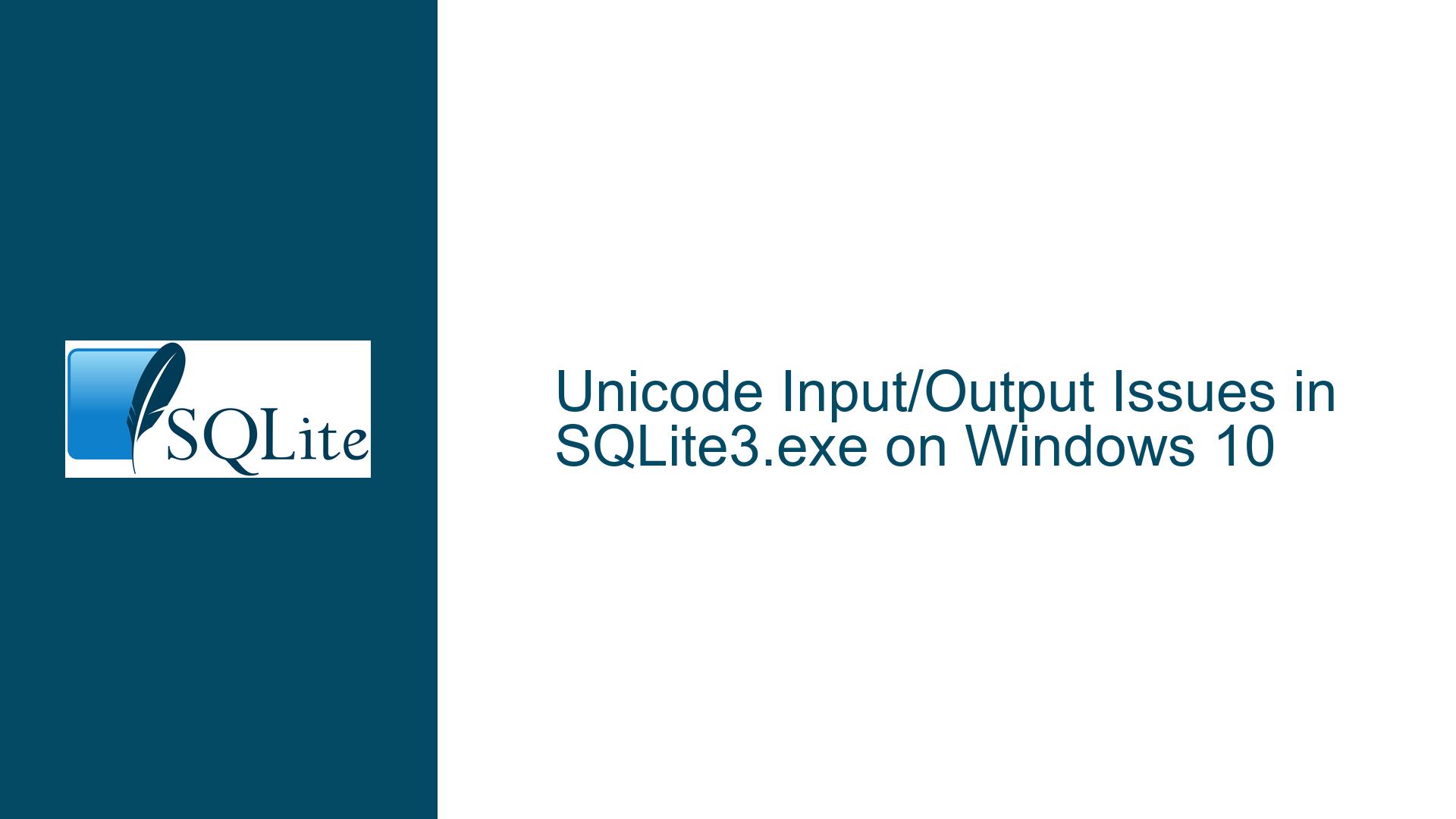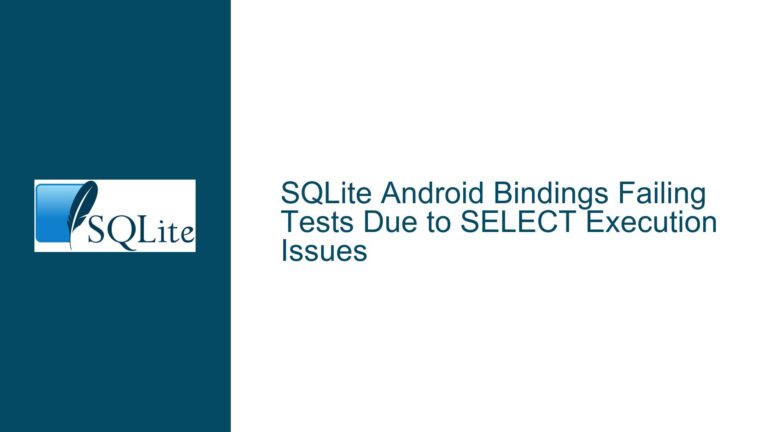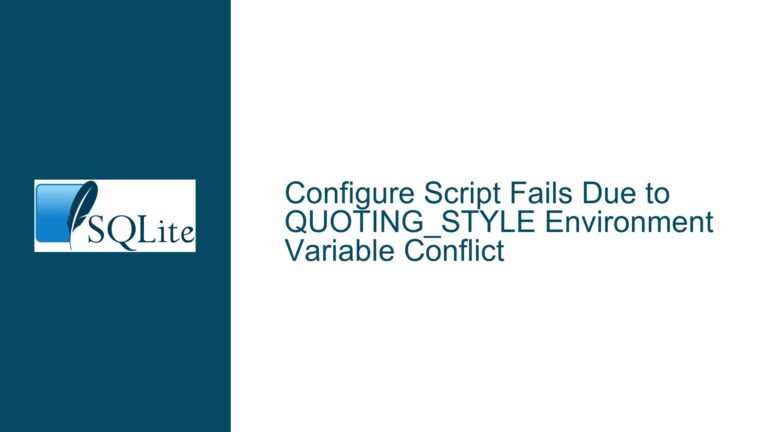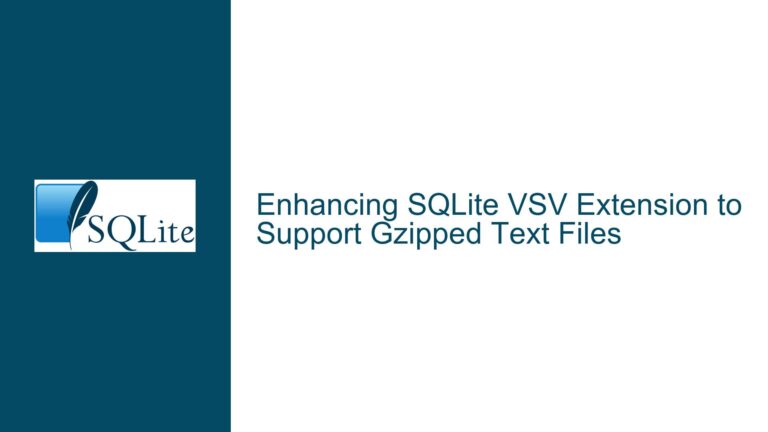Unicode Input/Output Issues in SQLite3.exe on Windows 10
Unicode Input/Output Failures in SQLite3.exe on Windows 10
Issue Overview
The core issue revolves around the inability of the SQLite3 shell (sqlite3.exe) to handle Unicode input and output correctly on Windows 10 systems. Users report that when attempting to input Unicode text into the SQLite3 shell, the console either hangs or terminates abruptly. Similarly, when querying a database that contains Unicode text, the output is often garbled or replaced with placeholder characters (e.g., ��������). This behavior persists despite the system’s console being configured to use UTF-8 (chcp 65001), which is the expected code page for Unicode support on Windows. Notably, other tools and programming languages (e.g., Python, Golang, DBeaver, SQLite Studio) handle the same Unicode data without issues, confirming that the problem is specific to the SQLite3 shell.
The issue manifests in several ways:
- Input Hangs: When attempting to input Unicode text directly into the SQLite3 shell, the console becomes unresponsive and must be terminated manually.
- Garbled Output: Querying a database containing Unicode text results in incorrect or unreadable output, even though the data is stored correctly and can be retrieved properly by other tools.
- Inconsistent Behavior Across Consoles: The problem occurs in both the traditional
cmd.exeand the modern Windows Terminal, despite both being configured to use UTF-8. Other console applications, such asgitandpsql, handle Unicode input/output without issues under the same conditions.
This issue is particularly problematic for users working with non-English locales or databases containing multilingual data. The inability to reliably input or retrieve Unicode text undermines the utility of the SQLite3 shell for many real-world applications.
Possible Causes
The root cause of the Unicode input/output issues in SQLite3.exe on Windows 10 appears to be a combination of factors related to the shell’s handling of Unicode text and its interaction with the Windows console subsystem. Below are the most likely contributing factors:
Inadequate Unicode Support in SQLite3 Shell: The SQLite3 shell may not be fully leveraging the Unicode capabilities of the Windows console. While the shell is capable of storing and retrieving Unicode data in databases, its console interface may not be properly configured to handle Unicode input/output. This could be due to the use of legacy functions (e.g.,
fgets()for input) that do not fully support Unicode, as opposed to modern alternatives likeReadConsoleW().Console Code Page Mismatch: Although the console is set to UTF-8 (
chcp 65001), the SQLite3 shell may not be interpreting or encoding the text correctly. This mismatch can lead to garbled output or input failures. The issue is exacerbated by the fact that the Windows console historically has had limited support for UTF-8, despite recent improvements in Windows 10.Font Limitations: While not the primary cause, the choice of console font can influence the display of Unicode characters. Some fonts may not include glyphs for certain Unicode characters, resulting in placeholder characters (e.g.,
��������) being displayed instead. However, this is unlikely to be the sole cause of the issue, as users have reported problems even with fonts that support a wide range of Unicode characters.Shell Termination on Unicode Input: The SQLite3 shell appears to terminate abruptly when processing certain Unicode characters. This behavior suggests a potential bug in the shell’s input handling logic, where it fails to properly process or validate Unicode input, leading to a crash or freeze.
Lack of Integration with Modern Console Features: The SQLite3 shell may not be fully compatible with modern console features introduced in Windows 10, such as Windows Terminal. While these features are designed to improve Unicode support, the shell may not be leveraging them effectively.
Inconsistent Behavior Across Windows Versions: The issue has been observed on multiple versions of Windows, including Windows 7, 8, 10, and Server editions. This suggests that the problem is not specific to a particular version of Windows but rather a fundamental limitation or bug in the SQLite3 shell.
Troubleshooting Steps, Solutions & Fixes
Addressing the Unicode input/output issues in SQLite3.exe on Windows 10 requires a combination of troubleshooting steps, workarounds, and potential fixes. Below is a detailed guide to resolving the issue:
Verify Console Configuration:
- Ensure that the console is set to UTF-8 by running
chcp 65001before launching the SQLite3 shell. This can be done manually or by adding the command to a startup script. - Check the console font settings and select a font that supports a wide range of Unicode characters, such as Consolas, DejaVu Sans Mono, or another Unicode-compatible font.
- Ensure that the console is set to UTF-8 by running
Test with Windows Terminal:
- Use Windows Terminal, which offers improved Unicode support compared to the traditional
cmd.exe. Launch Windows Terminal, set the code page to UTF-8 (chcp 65001), and then run the SQLite3 shell to see if the issue persists. - If the problem occurs in Windows Terminal as well, it suggests that the issue is not solely related to the console but rather the SQLite3 shell itself.
- Use Windows Terminal, which offers improved Unicode support compared to the traditional
Apply the Unicode Patch:
- A patch has been proposed to enable Unicode console input and output in the SQLite3 shell on Windows. This patch replaces the use of
fgets()withReadConsoleW(), which provides better support for Unicode input. - To apply the patch, download the modified source code, compile it using a compatible compiler (e.g., MinGW/gcc with the
-municodeoption), and test the resulting binary. - Note that applying the patch requires some familiarity with compiling C code and may not be suitable for all users.
- A patch has been proposed to enable Unicode console input and output in the SQLite3 shell on Windows. This patch replaces the use of
Use Alternative Tools:
- If the SQLite3 shell continues to exhibit issues, consider using alternative tools for interacting with SQLite databases. GUI tools like DBeaver and SQLite Studio offer robust Unicode support and may be more suitable for working with multilingual data.
- Alternatively, use programming languages like Python or Golang to interact with the database programmatically, as these languages typically have better Unicode support.
Report the Issue:
- If the issue persists and no suitable workaround is found, report it to the SQLite development team. While arbitrary users cannot open tickets in the main SQLite repository, the preferred method for reporting issues is through the SQLite forum.
- Provide detailed information about the problem, including the steps to reproduce it, the version of SQLite3.exe being used, and the operating system version.
Explore Non-Portable Workarounds:
- As a last resort, consider using a specific code page for the language you are working with. For example, use
chcp 855orchcp 866for Cyrillic characters. While this approach is not ideal and may result in some characters being converted to ASCII, it can provide a temporary solution for specific use cases.
- As a last resort, consider using a specific code page for the language you are working with. For example, use
Monitor for Updates:
- Keep an eye on updates to the SQLite3 shell, as future versions may include fixes or improvements for Unicode support on Windows. Regularly check the SQLite website and forum for announcements and patches.
By following these steps, users can mitigate the Unicode input/output issues in SQLite3.exe on Windows 10 and continue working with multilingual data effectively. While some solutions require technical expertise, others, such as using alternative tools or adjusting console settings, are accessible to a wide range of users.






